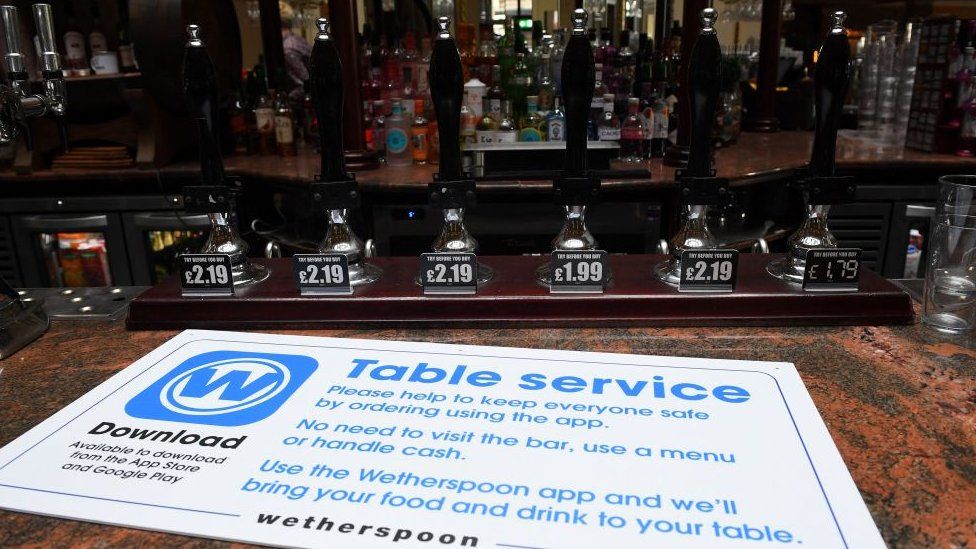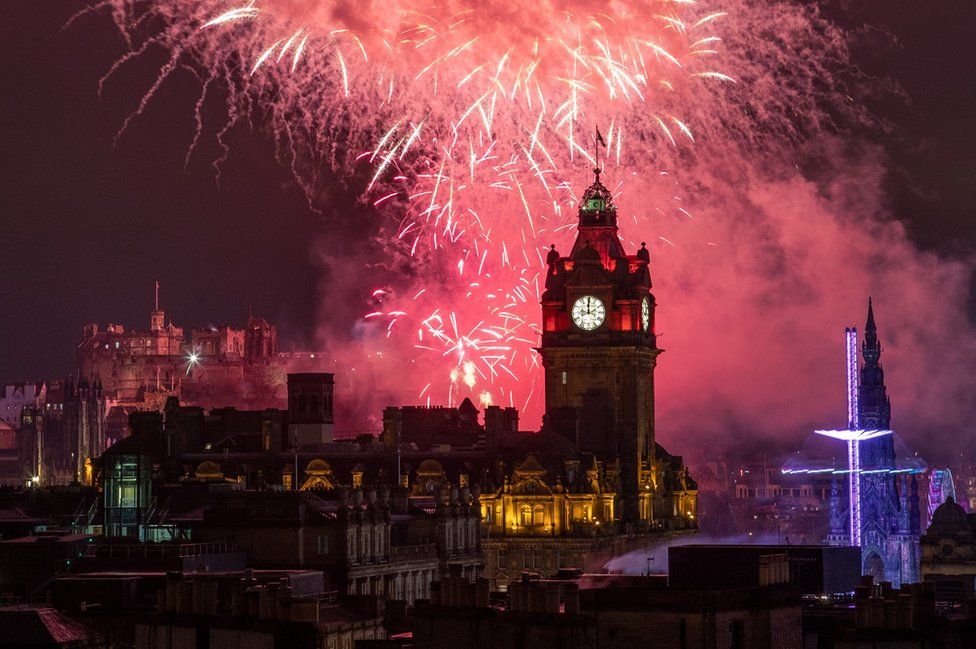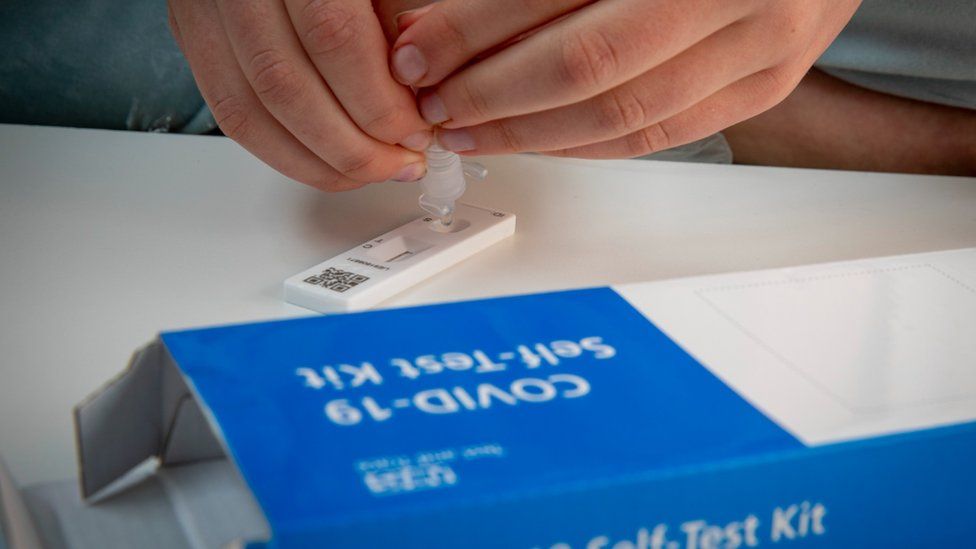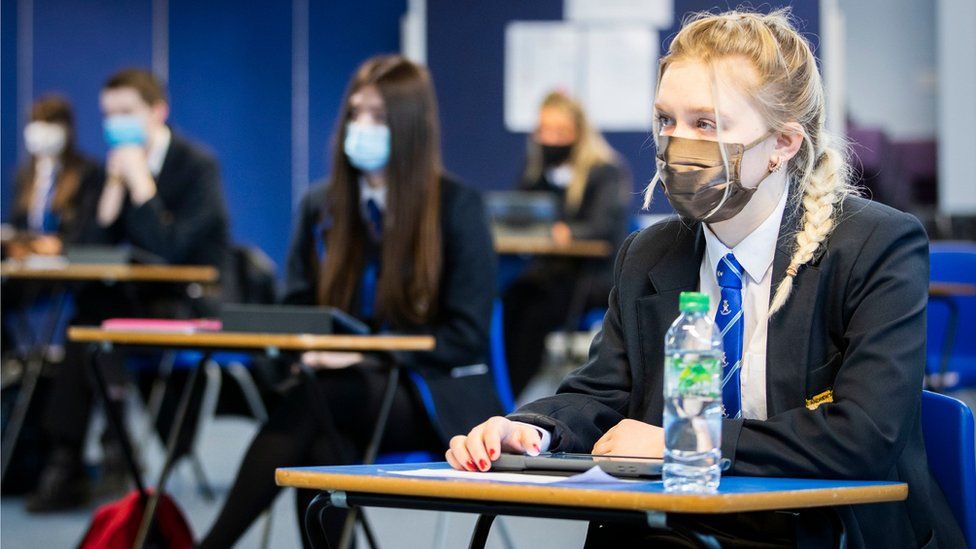Covid rules are being tightened again in Scotland as cases of the Omicron variant continue to surge.
More curbs on leisure and hospitality were introduced on 27 December, following limits on large events which came into effect on 26 December.
Christmas Day celebrations were allowed to take place as planned, although people are being advised to limit socialising to three households around the festivities and take a lateral flow test before mixing with others.
What has changed now?
 IMAGE SOURCE,GETTY IMAGES
IMAGE SOURCE,GETTY IMAGESFurther restrictions have been introduced for pubs, restaurants and other indoor public places for three weeks from 27 December.
Nightclubs also have to close for a period of at least three weeks, though they can stay open if they operate as a pub with table service and distancing.
Indoor hospitality and leisure venues will have to ensure there is a one metre distance between different groups of people, and table service will be required where alcohol is served.
There should be no more than three households in any group.
 IMAGE SOURCE,PA MEDIA
IMAGE SOURCE,PA MEDIAAnd for three weeks from 26 December, limits are in place on the size of public events. Those limits are:
- Up to 100 people at indoor standing events
- Up to 200 people at indoor seated events
- Up to 500 people, either seated or standing, at outdoor events.
This means the cancellation of large Hogmanay events, such as the famous celebrations in Edinburgh. Sporting events, such as football matches, will effectively be spectator-free.
Any events which do go ahead will have to introduce one metre physical distancing.
Non-professional indoor contact sports for adults will also be banned during the three-week period.
What restrictions were already in place?
A raft of new measures had already been introduced in an attempt to slow down the spread of the Omicron variant. These steps are a combination of guidance and laws.
People were asked to limit the number of contacts they had, and gather in groups of no more than three households in the run-up to Christmas Day, or whichever day people have their main celebration, when there will be no limits to gatherings.
Businesses are now legally required to take steps to reduce the spread of Covid, including bringing back physical distancing and screens.
There is also a legal requirement for employers to enable staff to work from home where possible.
Adults and children aged 12 and over still have to wear face coverings in all the same indoor settings as before, such as shops, hospitality venues and public transport. People are also being asked to wear masks in outdoor crowded areas such as Christmas markets.
 IMAGE SOURCE,GETTY IMAGES
IMAGE SOURCE,GETTY IMAGESIn hospitality, face coverings can be removed while dancing, drinking and dining. Indoor venues are required to reduce crowding and collect the contact details of customers to help with Test and Protect.
Retail and other sectors also have to ensure social distancing and manage customer flow.
The two metre distancing rule remains in healthcare settings such as hospitals, doctors’ surgeries and dentists.
Under the vaccine passport scheme which was introduced in October, anyone over the age of 18 must show proof – if asked – that they have had both doses of the vaccine before they are allowed entry to:
- Nightclubs and adult entertainment venues
- Unseated indoor live events with more than 500 people in the audience
- Unseated outdoor live events for more than 4,000 people
- Any event, of any nature, attended by more than 10,000 people
Proof of a negative lateral flow device test will also be accepted.
However, under the current restrictions many of the events covered by the scheme will not be allowed to go ahead just now.
Covid passports are also now required in similar situations in England.
Proof of a negative LFD test will be needed before people can visit someone in hospital or a care home, or accompany someone to a medical appointment.
What are the rules on self-isolation?
 IMAGE SOURCE,GETTY IMAGES
IMAGE SOURCE,GETTY IMAGESHousehold contacts of all Covid cases now have to isolate for 10 days, regardless of vaccination status and even if they initially get a negative PCR test.
Close contacts who are not in the same household must take a PCR test as soon as possible. As long as they have no symptoms and two weeks have passed since they received their second dose of the vaccine, they can end self-isolation if the test comes back negative.
If someone aged between five and 17 years old is identified as a close contact, they will need to take a PCR test – but can end self-isolation if it comes back negative.
The Scottish government says it is currently considering whether to adopt changes to self-isolation rules which are being introduced in England, where people will be able to end quarantine after seven days instead of 10 if they provide negative lateral flow results on day six and day seven.
Anyone travelling to the UK has to take a PCR or lateral flow test in the two days before their departure, and take a PCR test within 48 hours of arrival in the UK. They must then self-isolate until they have a negative result. Anyone who is not fully vaccinated must also take a PCR test eight days after arrival.
What about schools?
 IMAGE SOURCE,PA MEDIA
IMAGE SOURCE,PA MEDIAFirst Minister Nicola Sturgeon said that reopening schools as normal after the Christmas holidays was a priority.
Updated guidance for schools to reduce the risks of Covid was published last week.
Pupils and teachers in secondary schools must continue to wear face coverings and the 1m social distancing rule is still in place.
Whole classes no longer need to self-isolate when a pupil tests positive, with only the closest contacts of positive cases required to test and isolate.
The guidance provided in information letters sent to staff and the parents of pupils when they are in low-risk contact with positive cases was updated. It now has a stronger recommendation that those involved should take a lateral flow test before returning to school.
In addition, all school staff and secondary school pupils are being asked to take a lateral flow test twice a week.
Carbon dioxide monitors – which assess how well-ventilated a space is – are also required in schools and childcare settings.
Colleges and universities are assessing any steps they may need to take, with some are returning to online learning for the start of the new term



No comments:
Post a Comment
Note: only a member of this blog may post a comment.